Street photography. An entire genre dedicated to photographs taken on the street. How did it come about, what is it all about, and perhaps most importantly, how do I get in on it?
Characteristics
Rather than try to define the genre specifically, I think it's best to define by example characteristics. For instance, it's not photos of bridges and road signs. A form of photojournalism, street photographs are taken out in public - usually, as the name implies, on the street - and usually having other human beings as the subject. They are not portraits, but rather candid shots - often, the subject will not be aware of being photographed, or will realize it only after the fact. A majority of photos are a bit grainy, taken on medium-speed (400 ISO) black-and-white 35mm film, with a standard or wide-angle focal length. The camera often captures a very specific moment on the film, and the end effect conveys some emotion or theme, such as irony. In all, the genre is about photographs that are a "slice of life."
The Masters
Photography started out large. Press cameras, like the more modern Speed Graphic, took 4x5 sheet film. While they were arguably portable, were hardly inconspicuous. As 120 roll film became popular, so did smaller cameras such as the classic twin lens reflex architecture. But it wasn't until 35mm film came out that you could take a photo without getting noticed.

[Henri Cartier-Bresson, Behind the Gare St. Lazare, Paris. Image from Wikipedia]
Most people would agree that the great-grandfather of the genre, the all-knowing master, was a French man named Henri Cartier-Bresson (pronounced on-Ree Car-tee-AY breh-SAWN) (b.1908 - d.2004). Cartier-Bresson pretty much founded the idea of trying to capture a "decisive moment" on film. Furthermore, he knew that to observe the moment, you must not interfere. His camera always acted as an imaginary window to a particular point in space and time and was rarely acknowledged, possibly assisted by the fact that the shiny chrome parts of his camera were painted black.

[Garry Winogrand, Central Park Zoo, 1964. Image from Masters of Photography]
If Cartier-Bresson was Socrates, then the role of his student Plato was played by Garry Winogrand. Well, he wasn't actually a student, but he was a natural successor. People shoot photographs for a variety of reasons, but Winogrand did it because that was the only way he could live. He died leaving behind nearly 300,000 unedited images, and more than 2,500 undeveloped rolls of film. His published photos documented the mid-20th Century, particularly the 60's and 70's, and they typically exhibit some sort of wit or irony.
Watch Winogrand at work here (sorry, but it's overdubbed):
Nowadays, color film and digital have sort of taken the edge off street photography, and you'd struggle to mention modern masters of the genre. Yet, there are certain people I admire, such as Gary Gumanow (Flickr) and some of the work of Chris Weeks (who has a number of sites, but I prefer his Flickr site.
The Equipment
First off, you should know that every name I've mentioned so far has used one brand of camera - Leica. Cartier-Bresson used a Leica III and an M3. Winogrand used an M4. Gumanow uses an M6-TTL, among other cameras, and Weeks uses an MP (also a digital M9, but we won't go there...) The Leica camera, a bayonet-lens-mount "rangefinder" camera, was introduced in 1930, and underwent a few iterations before the Leica M3 - arguably the quinessential Leica - came out in 1954. They were used heavily in combat photography, because they are durable and reliable. I've had the pleasure of handling a Leica M3 - though it is small, it's built like a tank.
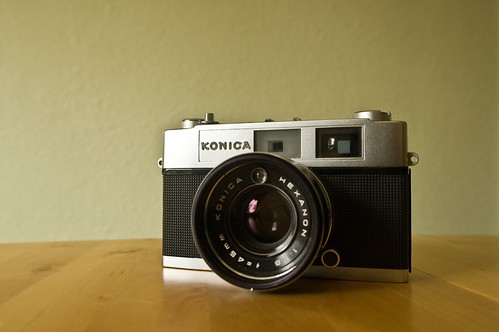
The Konica Auto S2. Photo by Flickr user sparkrobot
Now if you're like me, then a Leica has too much of a rabid cult following to be affordable anymore. However, there are solutions if you want to go about getting into street photography more cheaply! What you must shop for is a combination of speedy operation and inconspicuousness. The answer lies in the architecture of the 35mm rangefinder. First, the rangefinder is quick to focus, because you line up two identical images in the viewfinder to focus on a particular object. It is generally a bit quicker than dealing with a split-image prism or other manual-focus SLR focusing screen. As far as stealth is concerned, the rangefinder does not have a rising mirror as can be found in SLR cameras - in which you compose through the lens - so there is no mirror snap sound produced when you take a picture. The shutter just fires, and that's it. Leicas are renowned for their quiet focal plane shutters, but leaf shutters are also especially quiet. Therefore, I would recommend any 35mm rangefinder with a 50mm lens, preferably with a leaf shutter. I now use a Konica Auto S2, which has all these features, except that the lens focal length is actually 45mm. Don't worry about whether the lens is removable. You'll want something close to 50mm about 95% of the time. If not, then something wider will suffice to get up close and personal. You might want to carry around a Superheadz Ultra Wide and Slim knockoff for backup.
If you're using 35mm film, your best bet would be to load up on a 400-speed film such as Kodak Tri-X or my personal favorite, Ilford HP5+. They've got the perfect amount of grain to give you that "edgy" photojournalism look, without being too distracting. For developers, I'd recommend either Kodak HC-110 or Agfa Rodinal, but that's really more of a personal preference once you find one you like. If you're printing the old-fashioned way, try printing the full frame of the negative with some black border, the way Cartier-Bresson did.
Of course, who's to say you can't shoot color, or even a roll of Kodachrome before the end of the year? A few of my shots below feature Kodachrome. Street photography is what you make it and is more about the craft than the tools you use.
The Craft
Before you even attempt your first street shot, I can tell you that your biggest problem you're not close enough. Most of my street shots are taken from too far away. You need to get right up in the faces of your subjects, which may or may not be so easy depending on where you are. I'd imagine the attitudes of passersby in India are much different than those in Manhattan.
One thing that may help your sneakiness is taking the photograph without looking through the viewfinder - a true "point and shoot" technique. Simply set the camera's focus to what you think is right, aim to where you think the subject will be in frame, and shoot it. It's not like you've got anything to lose, especially if you're shooting black and white, which is relatively inexpensive. The downside is that the closer you are, the less latitude you have with respect to your focus setting. Wider apertures help.
(Note: I'm not a lawyer, so don't hold me responsible for the legality of this next paragraph...)
Generally speaking, you're perfectly within your rights to photograph people in public, because people in public have no expectation of privacy. The legal question becomes more muddy once you try using your photos commercially, though, since you need permission to use someone's likeness for financial gain. So while you're practicing your art, you can shoot away in public places and no one can really do anything about it - but it's also common sense to try to be as personable as possible if and when you get "caught." Remember, it's not like they're Michael Phelps, and it's not like they're smoking pot.

Shameless Self-Promotion
I've got a long way to go, but I thought I'd close with a handful of shots that I've taken, which you can find on my Flickr page.
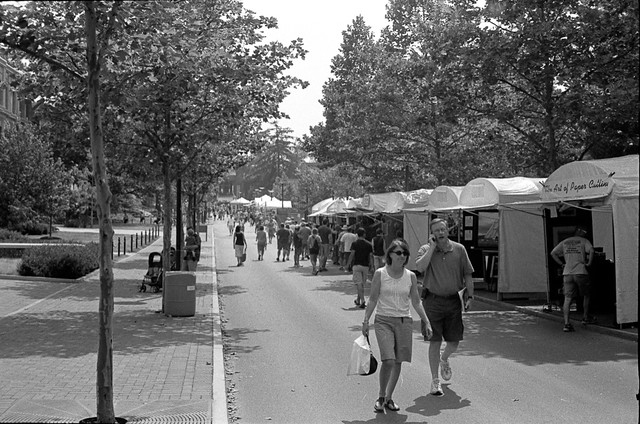
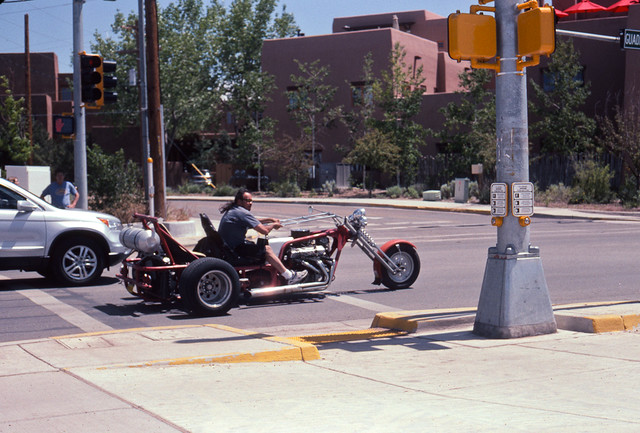
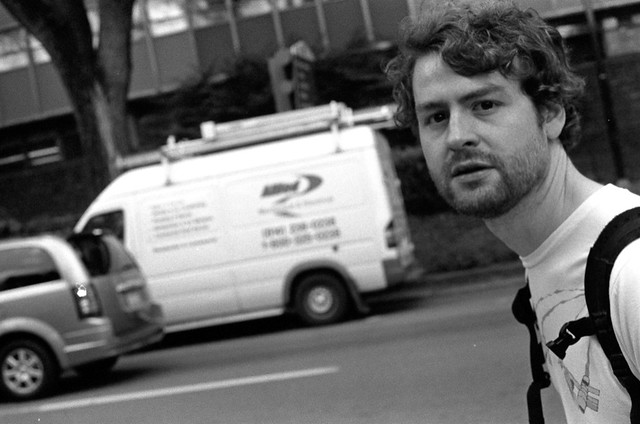
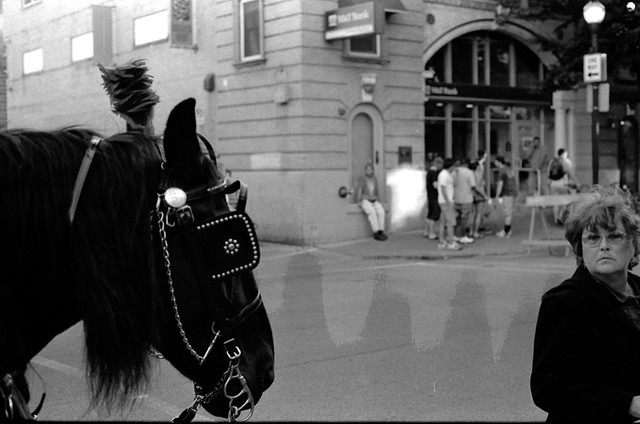
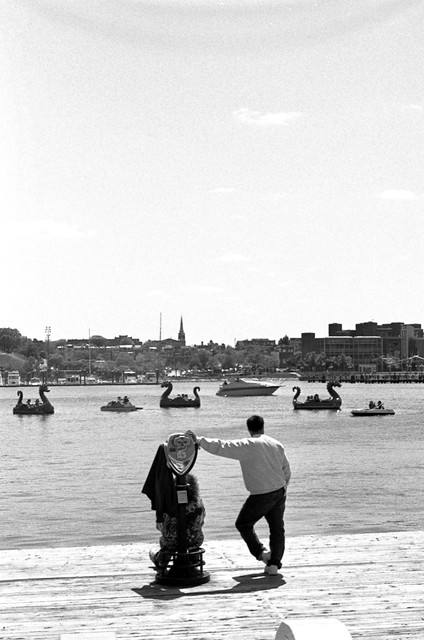
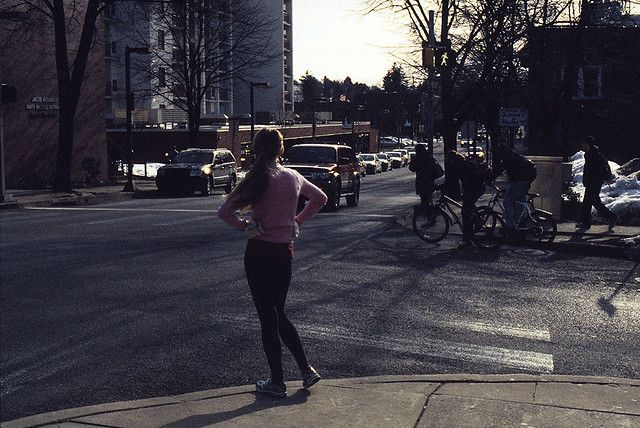
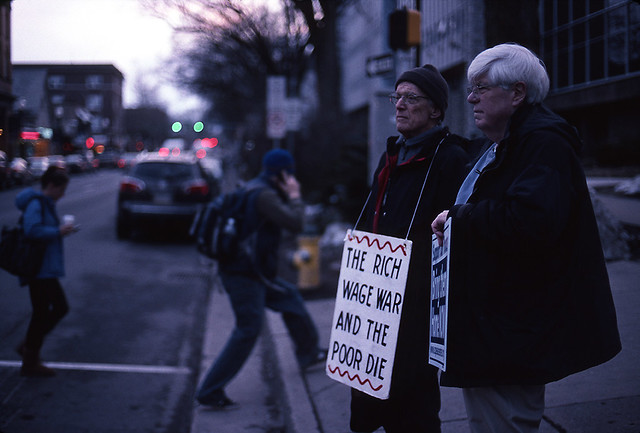
Dan Domme is a film photography enthusiast and PhD student in the Acoustics department of Penn State. He's been a serious photographer for the last two years, and now shoots nearly exclusively on film. (He even owns a sweet Hasselblad.)
You can view his Flickr stream at http://www.flickr.com/photos/yeknom02/ or his photography blog at http://dommephoto.wordpress.com/
Winogrand's camera (2002 article):
ReplyDeletehttp://www.cameraquest.com/LeicaM4G.htm
Winogrand interveiw:
http://www.youtube.com/watch?v=Tl4f-QFCUek Part 1
http://www.youtube.com/watch?v=-Zk1nkZ3-kE Part 2
can't find the original single version.
Great Guest Post Dan, I'll be including the link when I send out the monthly reminder to my local camera club. The Central Park Zoo photo is on of my favorites. It had even more "meaning" back when he took it.
2 days and change till the new 'cast (F5, F5, F5, F5 ...)
Yay, Konica Autio S2! Great, quiet camera for street photography. Yashica Electro 35 also good, and I'm in love with my newly acquired Voigtlander Bessa-R. Leica without the expense (well, not all the expense anyway). Russian lenses make the glass cheap and good too. Nice post.
ReplyDeleteOh and I meant to comment too, I was surprised at how many frames Winograd was firing off. Like he had it on motor drive or something. Makes me think I need to be less selective in my street shooting. He was also not afraid to get up close either. I'm still working on that part…
ReplyDeleteWow that photo by Henri Cartier-Bresson was a huge influence on the reason i wanted to take photos. i have never learned any photo history and never knew who he was till i went back to college a few years ago. but i had a postcard or a print of it from almost 15 years ago. i'm glad to find out i was inspired by "the great-grandfather of the genre, the all-knowing master" and did not even know it.
ReplyDeleteYou say "Winogrand used an M4." and yet directly above that statement is a YouTube still of him stood there with a double stroke M3 around his neck.
ReplyDelete